QuestionThis evening I saw a cat go into the rabbit nest and take a wild cottontail from it the rabbit were running everywhere they are aprox 2 weeks old as their eyes are open how should i feed the remaining 4 rabbits
AnswerHi Terry,
I am cutting and pasting from the House Rabbit Society web site (www.rabbit.org) for this:
I/My Dog/My Cat Found a Rabbit Nest! What Do I Do?
Rabbits hide their nests in plain view, often putting them in the open; for example, in the middle of the lawn, as well as in brush piles and long grass. If you find a nest that has been disturbed, do all you can to restore and protect it rather than bring the infants inside. If a dog has discovered the nest, keep your dog away from the area and reconstruct the nest with grasses. If need be, you can move the nest a few feet away where safer.
Rabbit mothers nurse their babies for approximately 5 minutes a day. They will be in the nest or nest box early in the morning and then again in the evening. The milk is very rich and the babies "fill up" to capacity within minutes. Mother rabbits do not "sit" on the babies to keep them warm as do some mammals and birds. They build a nest with fur and grasses which helps to keep the babies warm in between feedings. Do not force a mother rabbit to sit in the nest box. You can pick up the babies and see if they are feeding by checking the size of their stomachs (should not be sunken in), the pinkness of their skin and activity level (they should not be blue in color or sluggish in movement) and the amount of time that you hear them crying (baby bunnies should be quiet most of the day....if they are crying constantly then they are not getting fed). If you come across a nest of bunnies in the wild and the mother is no where to be seen, please DO NOT disturb them...this is normal. By removing them from the nest you are greatly reducing their chances of survival.
If your dog disturbs a nest or you find a wild bunny with its eyes open, please put him back if not injured. Mom will be coming back at night to call and feed him only once in the middle of the night. Do not take the bunny inside or feed him. That is the mom's job. IT IS A MATTER OF HIS/HER SURVIVAL AND UP TO US AS HUMANS TO LEAVE NATURE BE AND LET THE MOM CARE FOR HER YOUNG. We often hear of mothers moving their babies and their nests, and have seen moms come back every night for up to a week to look for her missing baby. Do not take the baby from the mom or she will be frantic.
I/My Dog/My Cat Destroyed a Rabbit Nest! What Do I Do?
Remake the nest as best you can with grasses, hay, straw in the same place. Nests can be moved to a safer place up to 10' away from the original site and can be reconstructed if necessary. To make a new nest, dig a shallow hole about 3" deep and put into it as much of the original material as you can recover, including the mother's fur. Add dried grass as needed, and put the young back. Mother rabbits return to the nest to nurse only at night, staying away as much as possible so as not to attract predators. To determine if the mother is returning, create a tic-tac-toe pattern over the nest with straw, grasses or tiny twigs. Wait 24 hours to see if the twigs have been disturbed. She may be able to feed them without moving the twigs much, so double check--If the babies look healthy, are warm, then the mother is coming back. If they are cold, dehydrated, get them to a professional; do not care for them yourself. Please contact a Wildlife Rehabilitator or rabbit vet immediately.
How Do I Know If the Baby Bunnies Need Help?
Very young wild baby bunnies with eyes closed and ears back rarely survive in captivity, even given the most expert human care; and so it is very important to determine whether they really need help. Try to assess whether the infants seem warm and healthy or cold, thin, and dehydrated. One test for dehydration is to gently pinch the loose skin at the back of the neck. If it stays in a "tent," or does not spring back in one second, the bunny is SEVERELY dehydrated and needs rehabilitation IMMEDIATELY by a professional rabbit vet or rehabber. Another test is to stroke the genital area to stimulate elimination. If the pee is brown and gritty, the mother rabbit has not been there to help the bunnies urinate. The brown, gritty urine is toxic, and the infant bunny must be cared for by a professional. Please contact a Wildlife Rehabilitator or rabbit vet immediately.
Older baby bunnies who are found outside of the nest may not be orphaned or in need of assistance. Baby cottontails are born without fur but develop a full coat in a week. Their eyes open in 10 days, and in three to four weeks they are weaned. At this age, they may explore the world outside of the nest but return there to sleep. They are not ignored by the mother but stay with the family group until four or five weeks of age. To determine whether a bunny of this age needs assistance, perform the dehydration test. Also look for bleeding, convulsing, fly larvae, broken limbs; if any, get to a rabbit vet or emergency vet immediately. If he is just out and about, leave him be. He is discovering his world, waiting for mom to return at night when we humans are asleep.
What If the Baby Bunny Is Injured?
Either call or take him to your local humane society or animal shelter/animal control. Call first as often they will come pick up the baby. If they don't have a wildlife center, they will refer you. If after hours, contact a local emergency rabbit vet or Rabbit Veterinarian.
The best thing you can do for an injured wild baby bunny is to get in touch with a skilled rehabilitator.
Great info on local rehabilitators can be found at The Wildlife Rehabilitation Information Directory
Is there anything I can do to avoid orphaning baby bunnies?
The harsh reality is that many of us who care about wild baby bunnies may be contributing to the suffering and death. House cats who roam outside will kill about every other time they go out. And unlike feral cats who hunt because they are hungry, and kill immediately, house cats maul and torment their prey, sometimes skinning baby bunnies alive. Cat owners need to provide managed outdoor habitats for their cats - such as windowboxes or pens. Providing a bell on your cat will help warn the wildlife if you cannot keep him inside.
Lawn chemicals can produce convulsing death in baby rabbits. According to the Poison Control Center for Animals, lawn applications that contain herbicides are not directly toxic to small animals; but they may make toxic plants more palatable to them and may make the animals sick for a few days. Products which contain insecticides, such as Dursban or Diazinion, which are added to many lawn products to control fleas or grubs in the lawn, are toxic.
The Bunny is Wild and Really Orphaned - How do I care for it?
Again, make sure you KNOW for sure the mom was killed and the bunnies are abandoned (not warm, etc). You will not see the mom. The mom will only come back in the middle of the night to feed her babies. If the mom was killed, the best thing you can do for a wild orphaned baby bunny is to get in touch with a skilled rehabilitator. In the meantime, call your local humane society or animal control and one of these vets for a wildlife referral: http://www.rabbit.org/vets/vets.html
http://www.morfz.com/PB_vets.html
A great directory of local rehabilitators can be found at: http://www.tc.umn.edu/~devo0028/contact.htm
The Bunny is Domestic (NOT WILD) and Really Orphaned - How do I care for it?
Remember the domestic/wild bunny mom only feeds her young usually once in the middle of the night. Don't assume she is not caring for them if you don't see her nurse them. Check their tummies to see if they are round and the babies are warm in the morning--this means she is caring for them. In the rare situation that you have an orphaned domestic bunny, such as when a domestic rabbit mom is sick or refuses to care for her young, you will need to feed the babies. Overfeeding is a leading cause of death in these youngsters which results in fatal intestinal disease.
Use Meyenberg Regular Goat milk (found at Safeway in the milk section or Whole Foods) or KMR KITTEN powder formula + follow directions on the can. (KMR better for domestics). It may be easiest to start with a 3 cc/ml syringe or an eyedropper. Some use pet nurser nipples on the end of a luer lock syringe, or a teat cannula on the end of a syringe. Feed only with the bunny sitting UPRIGHT, and point syringe down towards bottom or side of mouth, so if too much comes out, the baby does not aspirate! For those who are slow to learn nursing, SC fluids may be necessary to prevent electrolyte imbalance or dehydration (check with a vet on this only!!). Domestic buns with closed eyes should be fed 2 x a day, and the number of feedings gradually decreased until they are weaned. If their eyes are still closed, you need to stimulate their bottoms with a warm moist towel after feedings to help them to pee. (Domestics are weaned about 6 weeks; wild bunnies are weaned about 3-4 weeks for cottontails and 9 weeks for jacks). Bloat is commonly associated with too frequent feedings and too much at one time.
For WILD rabbits, do not feed at home, but get them to a professional rehabber. This is CRITICAL for their survival as they are not like domestics. See contacts under wild orphans.
Provide a soft nest area in a box with clean towels, and cover the babies so it is dark until their eyes are open. Do NOT provide extra heat if the room temperature is at least 65 to 70 degrees F because excessive heat can be fatal. If the room is cooler, then you may place a heating pad on a low setting under no more than HALF of the nest so the bunny can move to a cooler area if it gets too warm. If this is a wild rabbit, handle it ONLY when during feedings as excessive handling can be extremely stressful and potentially fatal. Wild rabbits usually don't need heat if furred and healthy.
You can use Regular Goat Milk found in the carton at your local grocery store.You can also use KMR (Kitten Milk Replacer) available at most pet stores for the handfeeding formula. Avoid ANY regular milk, puppy formulas, etc.
How much formula should I feed?
The following is a guideline for the daily amount to feed a TRULY orphaned bunny (mother was killed, etc.) Remember with wild bunnies, the mom only comes back at night to call and feed him; please put him back for her if just found and healthy. With domestics, the mom only feeds once or twice a day for only 5 minutes. Leave babies with the mom. For wild true orphans, see contacts for wildlife rehabbers under wild orphans.
Feeding of True Orphans Age + Amount (This WILL vary depending on type of rabbit. It is impossible over the Internet to see your particular rabbit, so this is only approximate.) Use Goat Milk or KMR, regular not low fat. Add a pinch of acidophilus (aka Probiotic) to the formula to promote healthy gut flora. Formulas vary depending on region. Avoid Esbilac. FEED TWICE A DAY ONLY.
Newborn to One Week: 2 - 2+1/2 cc/ml each feeding (two feedings per day).
1-2 weeks: 5-7 cc/ml each feeding (two feedings per day). (depending on bunny..may be much LESS if smaller rabbit!) Newborn babies (if eyes closed) all need to be stimulated to urinate and defecate prior to or following feeding until their eyes open. (Except Jackrabbits do not). *See how to below.
2-3 weeks: 7-13 cc/ml each feeding (two feedings). Domestic eyes open at about 10 days of age. Start introducing them to timothy and oat hay, pellets and water (always add fresh greens for wild ones).
3-6 weeks: 13-15 cc/ml each feeding (two feedings--again, may be LESS depending on size of rabbit! A cottontail will take so much less!! Half this at most.) Domestics are weaned about 6 weeks. Cottontails wean and release about 3-4 weeks and jackrabbits much later (9+ weeks).
Wild rabbits NEED a skilled wildlife rehabber. Please call your humane society or these contacts: http://www.tc.umn.edu/~devo0028/contact.htm
For domestic rabbits, if you have a healthy adult rabbit at home and you can collect cecotropes (the soft, chain-like droppings that the rabbit usually eats) then these can be mixed with the KMR to give the baby bunny normal bacteria for its intestinal tract. Only one cecotrope per day for 4-5 days is needed. This is particularly important for rabbits under one week of age. Also good is to sprinkle acidophilus powder, also called "Probiotic" from human capsules in the milk a little each time for healthy flora for both wild and domestic bunnies.
*After each feeding it is important to make the bunny defecate and urinate to keep the intestinal tract and urinary system running smoothly (only UNTIL their eyes are open). No need to do this for jackrabbits; they go on their own. Use a cotton ball moistened with warm water and gently stroke the anal area until the bunny starts producing stool and urine and keep stroking until the bunny stops. You are reproducing the behavior of the mother rabbit who would lick her young to stimulate them to go to the bathroom and to keep the nest clean.
As soon as their eyes are open, you may introduce the bunnies to plain alfalfa pellets, hay, such as oat hay, timothy, alfalfa, and for wild rabbits, in addition, add dark leafy veggies such as carrot tops, parsley, dandelion greens, etc. Dandelion greens and hay (timothy and oat hay) are extremely important for wild rabbits. You can add whole oats and oat groats from a feed store, and some grated carrots (about a tablespoon). The greens must be fresh, rinsed, and replaced if not eaten in a few hours or they dry out and get stale. You can place them in a cup of cold water with just the tops sticking out to keep them fresher for older rabbits. If this is a wild rabbit, you do not need to introduce pellets. If this is a domestic rabbit baby, then you may introduce plain pellets at 2 weeks of age (please refer to the handout Care of Rabbits for more information on diet). Wild rabbits should be released as soon as they are eating hay and greens and are approximately 5 inches in body length (cottontails) and run from you. They will be small, but the longer you keep them, the more agitated and difficult to handle they will become and the less likely their chances for survival in the wild. Release ONLY at dusk or dawn. Jackrabbits will be much larger and are released after 9 weeks when ready. Make sure they get exercise daily. The exception is the length/age rule is the jackrabbit. They are best released around 9 weeks of age, as they mature much slower than the brush/cottontails and need to develop strength. If they are ready, earlier, they will let you know.
WARNING: Jackrabbits really NEED a skilled wildlife rehabber as they can run from you, throw themselves into walls to get away; many have died or severely injured themselves in captivity as they are so very wild. Please DO NOT raise them if you are not a skilled wildlife rehabber. This is vital. Noises and sounds easily frighten the jackrabbit and they are not able to be handled after 9 weeks.
Jackrabbits really enjoy being raised together, whereas cottontails/brush bunnies may fight and do fine alone. Give them a carrier as their place of privacy (line with thick towels) with plenty of fresh hay, dandelion greens, carrot tops, parsley, wild grasses, and some whole oats. Brush bunnies/cottontails wean themselves pretty early after a few weeks. Jackrabbits continue on formula much longer, and most are weaned about 9 weeks. Replace the formula with about two teaspoons only of cut-up banana or apple and some whole oats for weaning. Again, wild rabbits need a skilled wildlife rehabber as it is critical to their survival.
Sources: Caring for Cricket - What Not To Do When You Find a Wild Baby Bunny by Julie Smith and Handout by Midwest Exotic Animal Hospital, and additional wild bunny info by M. Wilson (rehabber/HRS).
Keywords: orphan, orphaned, wild rabbits, baby bunnies.
For more information, please check our FAQ site before emailing a question:
For further questions, please email: wildbunnyrehab@yahoo.com
Other Resources
Caring For Orphans
Newborn Baby Bunny Facts

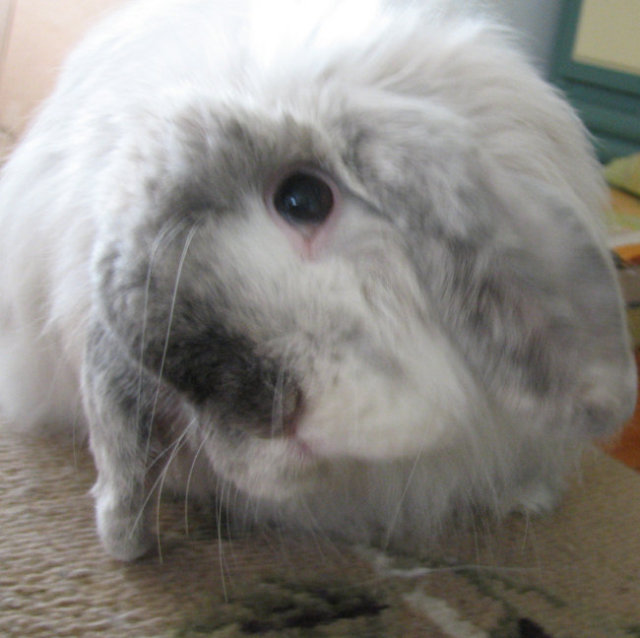 Staph. cohnii causing ear infection
Question
8 months of tilt
The results of a culture (pus
Staph. cohnii causing ear infection
Question
8 months of tilt
The results of a culture (pus
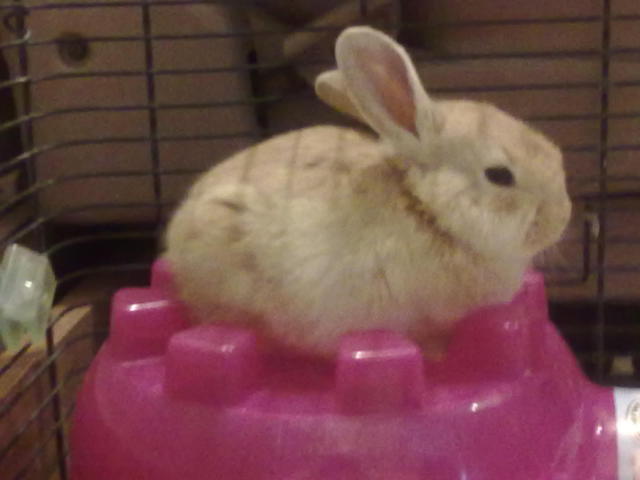 Squishy
QuestionSquishy, Fluffy Bunny.
QUESTION: My Sist
Squishy
QuestionSquishy, Fluffy Bunny.
QUESTION: My Sist
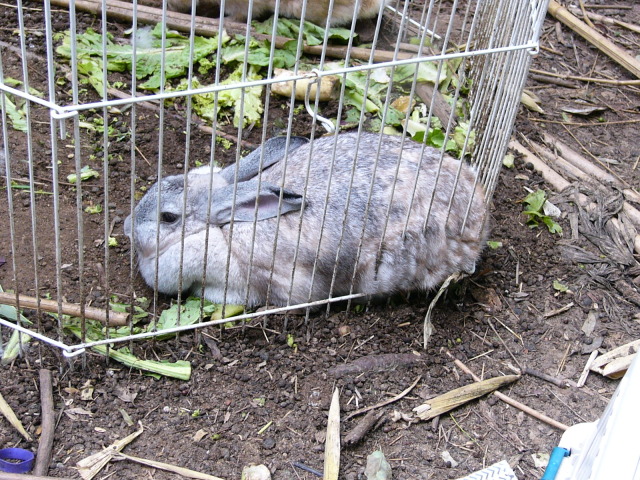 Is this a meat rabbit breed?
Question
big doe
This doe is a large rabbit. Can
Is this a meat rabbit breed?
Question
big doe
This doe is a large rabbit. Can
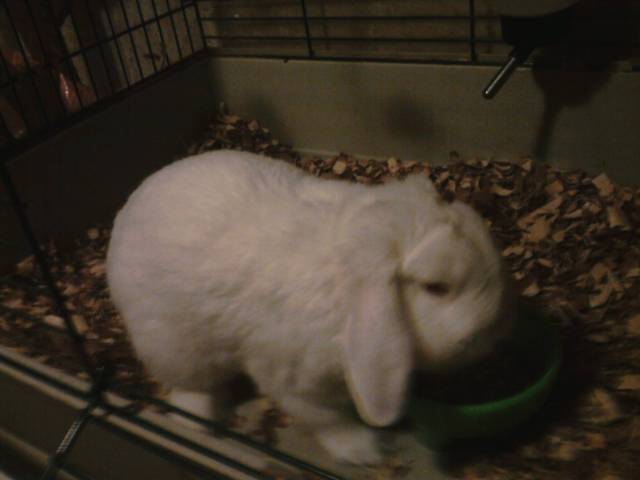 What kind of rabbit do I have?
QuestionQUESTION: I was given a rabbit for a classroom
What kind of rabbit do I have?
QuestionQUESTION: I was given a rabbit for a classroom
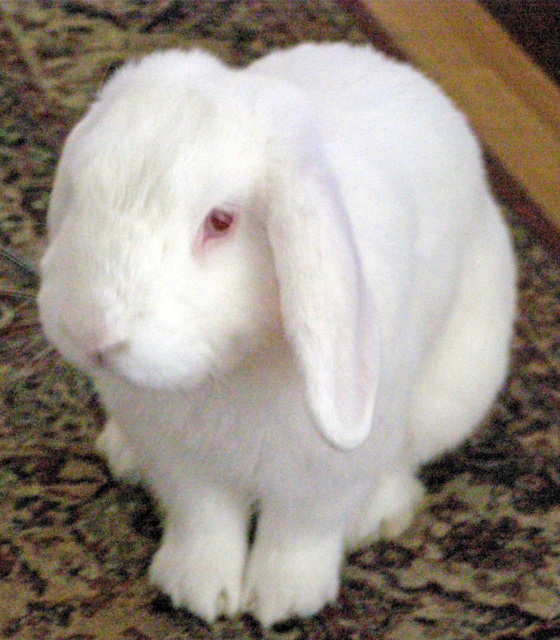 Male rabbit is spraying and pooping everyware
Question
Marshmellow
I have a male rabbit about 2 yrs o
Male rabbit is spraying and pooping everyware
Question
Marshmellow
I have a male rabbit about 2 yrs o